
Important Time Factors Related to Patents
If you think you may be interested in getting foreign patents, it is very important that you apply for a patent before making your invention public. Making an invention public can be offering the invention for sale or selling the invention, having it described in a publication, or revealing it to anyone without a confidential disclosure agreement where they agree to keep your invention secret.
File a Patent Application in the US, Then File for International Patents
Because of international agreements with most countries, you can file a US patent application and then file for international patent applications within one year of the US filing date and have the advantage of the original US filing date in the foreign countries. After one year from the US filing date you no longer have the advantage of the US filing date and, if the invention has been made public, you will not be able to file in most of the foreign countries. Canada is an exception, They allow filing a patent within two years of making the invention public as explained on https://vinnews.com/2022/01/01/get-help-with-patent-protection-from-inventhelp/ post.

You Lose Your Right to File for a Patent If You Don’t File in the US Within One Year of Making the Invention Public
In the US you can actually apply for a patent application within one year of making the invention public. If you wait more than a year after making the invention public, the invention becomes public property and you are no longer able to obtain a valid patent in the US. Exceptions are make for testing of the invention. That is why it is advisable to have professional help from agencies such as InventHelp patent agency.
You Should Apply for a Patent Before Making the Invention Public
It is always best to apply for a patent before making the invention public. If you rely on confidential disclosures to reveal the invention to others and they make the invention public, you may still lose your patent rights because of the public disclosure.




